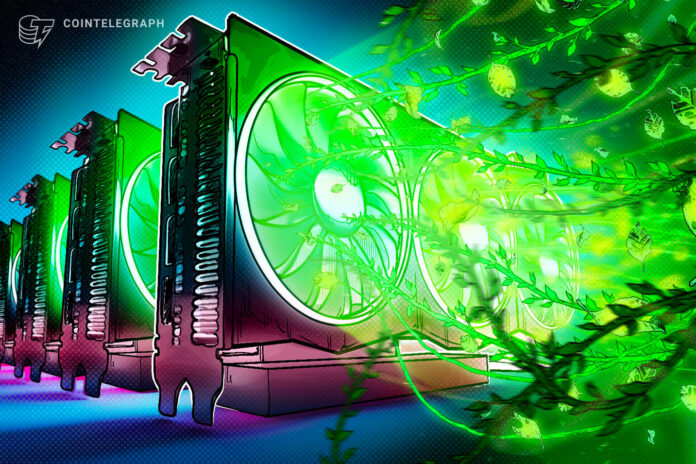Bitcoin (BTC) mining’s environmental impact has always been a controversial topic. On the one hand, critics emphasize that securing the Bitcoin network takes more power than some whole countries’ annual electricity consumption. On the other hand, much of the crypto community argues that it is a necessary activity that has enabled the Bitcoin blockchain to remain extremely resilient against external attacks with an almost 99.99% uptime throughout over 14 years of its history.
However, recent developments in the market have provided an opportunity for participants to make Bitcoin mining finally sustainable.
Bitcoin mining doesn’t deserve its bad reputation
Before going over the benefits themselves, it’s essential to first get some facts straight about Bitcoin mining. With comparisons to nations’ energy consumption and estimates that a single BTC transaction has a carbon footprint of nearly 820,000 Visa transactions, it should be highlighted that this activity doesn’t actually produce any emissions.

Instead, this “dirty work” is done by the power plants that supply the electricity to the mining rigs. Similarly to households or other business entities, miners only use the electrical infrastructure that exists in any given location.
Ever since Tesla stopped accepting Bitcoin payments in May 2021, citing environmental concerns, many have jumped on the bandwagon to criticize the blockchain network’s energy consumption. However, while it is important to address Bitcoin mining’s high electricity usage, it should not be done in a vacuum, as it is not the only power-hungry industry out there.
Related: Bitcoin ETFs: Even worse for crypto than central exchanges
According to the Bitcoin Mining Council, BTC mining consumes only a fraction of the energy required to power industries, such as construction (3.77%), finance and insurance (4.45%), shipping (5.41%) and aviation (5.43%). It even takes nearly 2.6 times the electricity to mine gold than to secure the Bitcoin network. And that’s without even discussing the disposal of electronic devices, as well as the agriculture and livestock industries, which are among those with the most significant environmental footprints.
Considering the above, it seems unfair to point out Bitcoin mining’s high electricity usage without mentioning how much power other industries consume each day.
Mining is becoming an increasingly sustainable industry
Despite controversies around the topic, the fact remains that it takes a significant amount of electricity to secure and maintain the Bitcoin network. The question is how to make Bitcoin more sustainable.
One solution would be to combine Bitcoin mining with other business activities in a beneficial manner. For example, hydro-cooling mining farms can supply heat to greenhouses, fish farms, buildings and even entire communities. While only eight WhatsMiners are needed to warm a 10,000-square-foot greenhouse, increasing water temperature by 10 degrees Celsius via mining rigs can shorten the period of growth of salmon in fish farms by up to three times. Another potential use case includes developing small hydropower plants to co-consume electricity with local communities.
Related: Don’t be naive — BlackRock’s ETF won’t be bullish for Bitcoin
Using associated petroleum gas (APG) to power Bitcoin mining rigs is also a key highlight in this field. As you may already know, APG is a byproduct of oil drilling. As it is not always worthwhile for producers to use it, they regularly burn it on-site. The latter process is called gas flaring, which led to 2.7 billion tonnes of CO2 equivalent emissions in 2021, along with the gas wasted in venting and methane leaks.
Instead of wasting this resource, Bitcoin miners can transform APG into energy to power their rigs. By preventing flarings, this activity can have a favorable effect on the environment. In fact, a report revealed that Bitcoin mining can decrease the percentage of flared gas by each oil producer by 80%.
At the same time, researchers have also found that it is by far the most cost-efficient way to decrease emissions, surpassing the values of wind and solar by multiple times. This is probably why many smaller oil and gas companies in the United States are mining BTC with flared gas.
The road to a greener Bitcoin
As Bitcoin miners have been migrating to countries where they have access to cheaper energy in the form of renewables, this has presented an opportunity for market participants to increase the industry’s sustainability.
With initiatives like preventing gas flaring and combining it with other business activities, the long-term goal is to make Bitcoin mining eco-friendly. Ideally, every industry should become as sustainable as possible while minimizing the harm caused to the environment. Putting in effort to make this possible is what being responsible market participants is about.
Bitcoin mining is already doing a lot to transform the energy sector due to miners being very flexible in their electricity consumption. And as this industry’s sustainability improves in the years ahead, it will attract many large-scale investors who are interested in investing in eco-friendly businesses.
Didar Bekbauov is the CEO of Bitcoin mining company Xive, which he co-founded in 2019. He previously served as a managing partner at Hive Mining. He holds an undergraduate degree from Kazakh-British Technical University and a master’s degree in financial management from Robert Gordon University.
This article is for general information purposes and is not intended to be and should not be taken as legal or investment advice. The views, thoughts and opinions expressed here are the author’s alone and do not necessarily reflect or represent the views and opinions of Cointelegraph.
Hits: 0











